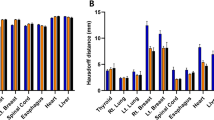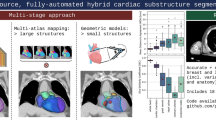Abstract
Purpose
This study aimed to quantitatively estimate the changes in breast volume associated with radiotherapy in patients undergoing breast-conserving surgery and whole-breast irradiation (WBI).
Methods
Pre-WBI simulation computed tomography (CT) scans and post-WBI follow-up chest CT scans from a total of 1,151 breast cancer patients were analyzed using a deep-learning-driven auto-segmentation approach. The CT-based asymmetry index (CTAI) was calculated by dividing the volume of the irradiated breast by the volume of the contralateral breast. Significant breast shrinkage was defined as a CTAI < 0.85. To quantify changes in CTAI over the follow-up period, the CTAI ratio was determined as the post-WBI CTAI divided by the pre-WBI CTAI. A multivariate logistic regression analysis was conducted to identify potential variables associated with post-WBI significant breast shrinkage.
Results
The median CTAI values for pre- and post-WBI CT scans were 0.973 (interquartile range: 0.887–1.069) and 0.866 (interquartile range: 0.773–0.967), respectively. The difference between them was statistically significant (p < 0.001). Following WBI, there was an increase in the rate of significant breast shrinkage from 16.3 to 44.8%. The CTAI ratio showed a negative association with the time interval (p < 0.001, Pearson r = − 0.310). In the multivariate logistic regression analysis, lower pre-WBI CTAI, younger age, and longer interval between CT scans were found to be significantly associated with a higher occurrence of post-WBI significant breast shrinkage.
Conclusion
Breast volume decreases following WBI, and this decrease is correlated with an increased duration after WBI. These findings highlight the long-term consequences of WBI on breast asymmetry.





Similar content being viewed by others
Data availability
The datasets used and/or analysed during the current study available from the corresponding author on reasonable request.
Abbreviations
- BCS:
-
Breast-conserving surgery
- CNN:
-
Convolutional deep neural network
- CI:
-
Confidence interval
- CT:
-
Computed tomography
- CTAI:
-
CT-based asymmetry index
- DVH:
-
Dose-volume histogram
- HI:
-
Homogeneity index
- IQR:
-
Interquartile range
- OR:
-
Odds ratio
- WBI:
-
Whole-breast irradiation
References
Sung H, Ferlay J, Siegel RL et al (2021) Global cancer statistics 2020: GLOBOCAN estimates of incidence and mortality worldwide for 36 cancers in 185 countries. CA Cancer J Clin 71:209–249. https://doi.org/10.3322/caac.21660
Kang MJ, Won Y-J, Lee JJ et al (2022) Cancer statistics in Korea: incidence, mortality, survival, and prevalence in 2019. Cancer Res Treat 54:330–344. https://doi.org/10.4143/crt.2022.128
Giaquinto AN, Sung H, Miller KD et al (2022) Breast cancer statistics, 2022. CA Cancer J Clin 72:524–541. https://doi.org/10.3322/caac.21754
Kang SY, Lee SB, Kim YS et al (2021) Breast cancer statistics in Korea, 2018. J Breast Cancer 24:123. https://doi.org/10.4048/jbc.2021.24.e22
EBCTCG (Early Breast Cancer Trialists’ Collaborative Group) (2011) Effect of radiotherapy after breast-conserving surgery on 10-year recurrence and 15-year breast cancer death: meta-analysis of individual patient data for 10,801 women in 17 randomised trials. Lancet 378:1707–1716. https://doi.org/10.1016/S0140-6736(11)61629-2
Wojtyla C, Bertuccio P, Wojtyla A, La Vecchia C (2021) European trends in breast cancer mortality, 1980–2017 and predictions to 2025. Eur J Cancer 152:4–17. https://doi.org/10.1016/j.ejca.2021.04.026
Straub JM, New J, Hamilton CD et al (2015) Radiation-induced fibrosis: mechanisms and implications for therapy. J Cancer Res Clin Oncol 141:1985–1994. https://doi.org/10.1007/s00432-015-1974-6
Waljee JF, Hu ES, Newman LA, Alderman AK (2008) Predictors of breast asymmetry after breast-conserving operation for breast cancer. J Am Coll Surg 206:274–280. https://doi.org/10.1016/j.jamcollsurg.2007.07.029
Dahlbäck C, Ullmark JH, Rehn M et al (2017) Aesthetic result after breast-conserving therapy is associated with quality of life several years after treatment. Swedish women evaluated with BCCT.core and BREAST-Q™. Breast Cancer Res Treat 164:679–687. https://doi.org/10.1007/s10549-017-4306-5
Olivotto IA, Link E, Phillips C et al (2020) International comparison of cosmetic outcomes of breast conserving surgery and radiation therapy for women with ductal carcinoma in situ of the breast. Radiother Oncol 142:180–185. https://doi.org/10.1016/j.radonc.2019.07.024
Batenburg MCT, Gregorowitsch ML, Maarse W et al (2020) Patient-reported cosmetic satisfaction and the long-term association with quality of life in irradiated breast cancer patients. Breast Cancer Res Treat 179:479–489. https://doi.org/10.1007/s10549-019-05470-y
Brunt AM, Haviland JS, Wheatley DA et al (2020) Hypofractionated breast radiotherapy for 1 week versus 3 weeks (FAST-Forward): 5-year efficacy and late normal tissue effects results from a multicentre, non-inferiority, randomised, phase 3 trial. Lancet 395:1613–1626. https://doi.org/10.1016/S0140-6736(20)30932-6
Stolpner I, Heil J, Riedel F et al (2021) Long-term patient satisfaction and quality of life after breast-conserving therapy: a prospective study using the BREAST-Q. Ann Surg Oncol 28:8742–8751. https://doi.org/10.1245/s10434-021-10377-4
Immink JM, Putter H, Bartelink H et al (2012) Long-term cosmetic changes after breast-conserving treatment of patients with stage I–II breast cancer and included in the EORTC ‘boost versus no boost’ trial. Ann Oncol 23:2591–2598. https://doi.org/10.1093/annonc/mds066
Chapman BV, Lei X, Patil P et al (2020) Quantitative 3-dimensional photographic assessment of breast cosmesis after whole breast irradiation for early stage breast cancer: a secondary analysis of a randomized clinical trial. Adv Radiat Oncol 5:824–833. https://doi.org/10.1016/j.adro.2020.04.035
Cardoso MJ, Cardoso J, Amaral N et al (2007) Turning subjective into objective: the BCCT.core software for evaluation of cosmetic results in breast cancer conservative treatment. Breast 16:456–461. https://doi.org/10.1016/j.breast.2007.05.002
Fitzal F, Krois W, Trischler H et al (2007) The use of a breast symmetry index for objective evaluation of breast cosmesis. Breast 16:429–435. https://doi.org/10.1016/j.breast.2007.01.013
Batenburg MCT, Bartels M, Maarse W et al (2022) Factors associated with late local radiation toxicity after post-operative breast irradiation. Breast J 2022:1–13. https://doi.org/10.1155/2022/6745954
Chung SY, Chang JS, Choi MS et al (2021) Clinical feasibility of deep learning-based auto-segmentation of target volumes and organs-at-risk in breast cancer patients after breast-conserving surgery. Radiat Oncol 16:44. https://doi.org/10.1186/s13014-021-01771-z
Jégou S, Drozdzal M, Vazquez D et al (2017) The one hundred layers tiramisu: fully convolutional DenseNets for semantic segmentation. IEEE conference on computer vision and pattern recognition workshops (CVPRW). IEEE, Honolulu, pp 1175–1183
Kingma DP, Ba J (2017) Adam: a method for stochastic optimization. ArXiv. https://doi.org/10.48550/arXiv.1412.6980.
Benjamini Y, Hochberg Y (1995) Controlling the false discovery rate: a practical and powerful approach to multiple testing. J R Stat Soc Ser B Stat Methodol 57:289–300. https://doi.org/10.1111/j.2517-6161.1995.tb02031.x
Yarnold J, Ashton A, Bliss J et al (2005) Fractionation sensitivity and dose response of late adverse effects in the breast after radiotherapy for early breast cancer: long-term results of a randomised trial. Radiother Oncol 75:9–17. https://doi.org/10.1016/j.radonc.2005.01.005
Barnett GC, Wilkinson JS, Moody AM et al (2012) Randomized controlled trial of forward-planned intensity modulated radiotherapy for early breast cancer: interim results at 2 years. Int J Radiat Oncol Biol Phys 82:715–723. https://doi.org/10.1016/j.ijrobp.2010.10.068
Fujii T, Yamaguchi S, Yajima R et al (2012) Accurate assessment of breast volume by computed tomography using three-dimensional imaging device. Am Surg 78:933–935. https://doi.org/10.1177/000313481207800930
Osman NM, Botros SM, Ghany AFA, Farid AM (2015) Contralateral breast volume measurement during chest CT for postmastectomy breast reconstruction. Int J Comput Assist Radiol Surg 10:141–147. https://doi.org/10.1007/s11548-014-1061-5
Collette S, Collette L, Budiharto T et al (2008) Predictors of the risk of fibrosis at 10 years after breast conserving therapy for early breast cancer—a study based on the EORTC trial 22881–10882 ‘boost versus no boost.’ Eur J Cancer 44:2587–2599. https://doi.org/10.1016/j.ejca.2008.07.032
Donovan E, Bleakley N, Denholm E et al (2007) Randomised trial of standard 2D radiotherapy (RT) versus intensity modulated radiotherapy (IMRT) in patients prescribed breast radiotherapy. Radiother Oncol 82:254–264. https://doi.org/10.1016/j.radonc.2006.12.008
Funding
The authors have not disclosed any funding.
Author information
Authors and Affiliations
Contributions
THL was responsible for data analysis and manuscript writing. SHA was responsible for data acquisition and analysis. KC was responsible for data acquisition and project administration. WP, WKC, NK, and TGK were responsible for data acquisition. HK was responsible for study designing, manuscript writing, and project administration. All authors contributed to the revision of the manuscript and approval of the final manuscript.
Corresponding author
Ethics declarations
Competing interests
All authors declare no financial or non-financial competing interests.
Ethical approval
This study was approved by the Institutional Review Board of Samsung Medical Center (approval no. 2021–04-175) before gathering patient information.
Consent to participate
The requirement for informed consent was waived because of the retrospective nature of the study.
Additional information
Publisher's Note
Springer Nature remains neutral with regard to jurisdictional claims in published maps and institutional affiliations.
Supplementary Information
Below is the link to the electronic supplementary material.
10549_2023_7146_MOESM1_ESM.pdf
The receiver operating curve of the total points from the nomogram and significant breast shrinkage after whole-breast irradiation. Supplementary file1 (PDF 73 KB)
Rights and permissions
Springer Nature or its licensor (e.g. a society or other partner) holds exclusive rights to this article under a publishing agreement with the author(s) or other rightsholder(s); author self-archiving of the accepted manuscript version of this article is solely governed by the terms of such publishing agreement and applicable law.
About this article
Cite this article
Lee, T.H., Ahn, S.H., Chung, K. et al. Quantitative assessment of breast volume changes after whole-breast irradiation for breast cancer using breast auto-segmentation. Breast Cancer Res Treat 203, 205–214 (2024). https://doi.org/10.1007/s10549-023-07146-0
Received:
Accepted:
Published:
Issue Date:
DOI: https://doi.org/10.1007/s10549-023-07146-0




